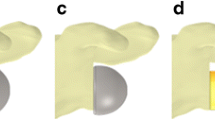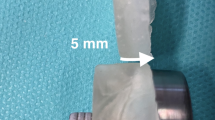Abstract
Purpose
To determine how different combinations of humeral stem and glenosphere designs for reverse shoulder arthroplasty (RSA) influence range of motion (ROM) and muscle elongation.
Methods
A computed tomography scan of a non-pathologic shoulder was used to simulate all shoulder motions, and thereby compare the ROM and rotator cuff muscle lengths of the native shoulder versus 30 combinations of humeral components (1 inlay straight stem with 155° inclination and five onlay curved stems with 135°, 145° or 155° inclinations, using concentric, medialized or lateralized trays) and glenospheres (standard, large, lateralized, inferior eccentric and bony increased-offset (BIO-RSA)).
Results
Only five of the 30 combinations restored ≥ 50% of the native ROM in all directions: the 145° onlay stem (concentric tray) combined with lateralized or inferior eccentric glenospheres and the 145° stem (lateralized tray) combined with either a large, lateralized or inferior eccentric glenosphere. Lengthening of the supraspinatus and infraspinatus, observed for all configurations, was greatest using onlay stems (7–30%) and BIO-RSA glenospheres (13–31%). Subscapularis lengthening was observed for onlay stems combined with BIO-RSA glenospheres (5–9%), while excessive subscapularis shortening was observed for the inlay stem combined with all glenospheres except the BIO-RSA design (> 15%).
Conclusions
The authors suggest implanting 145° onlay stems, with concentric or lateralized trays, together with lateralized or inferior eccentric glenospheres.








Similar content being viewed by others
References
Boileau P, Watkinson DJ, Hatzidakis AM, Balg F (2005) Grammont reverse prosthesis: design, rationale, and biomechanics. J Shoulder Elb Surg 14(1 Suppl S):147S–161S. https://doi.org/10.1016/j.jse.2004.10.006
Barco R, Savvidou OD, Sperling JW, Sanchez-Sotelo J, Cofield RH (2016) Complications in reverse shoulder arthroplasty. EFORT Open Rev 1(3):72–80. https://doi.org/10.1302/2058-5241.1.160003
Ladermann A, Denard PJ, Boileau P, Farron A, Deransart P, Terrier A, Ston J, Walch G (2015) Effect of humeral stem design on humeral position and range of motion in reverse shoulder arthroplasty. Int Orthop 39(11):2205–2213. https://doi.org/10.1007/s00264-015-2984-3
Hamilton MA, Roche CP, Diep P, Flurin PH, Routman HD (2013) Effect of prosthesis design on muscle length and moment arms in reverse total shoulder arthroplasty. Bull Hosp Joint Dis (2013) 71 Suppl 2:S31-35
Berhouet J, Garaud P, Favard L (2014) Evaluation of the role of glenosphere design and humeral component retroversion in avoiding scapular notching during reverse shoulder arthroplasty. J Shoulder Elb Surg 23(2):151–158. https://doi.org/10.1016/j.jse.2013.05.009
Ladermann A, Denard PJ, Boileau P, Farron A, Deransart P, Walch G (2018) What is the best glenoid configuration in onlay reverse shoulder arthroplasty? Int Orthop 42(6):1339–1346. https://doi.org/10.1007/s00264-018-3850-x
Werner BS, Chaoui J, Walch G (2018) Glenosphere design affects range of movement and risk of friction-type scapular impingement in reverse shoulder arthroplasty. The Bone & Joint Journal 100-b (9):1182-1186. doi:https://doi.org/10.1302/0301-620x.100b9.Bjj-2018-0264.R1
Virani NA, Cabezas A, Gutierrez S, Santoni BG, Otto R, Frankle M (2013) Reverse shoulder arthroplasty components and surgical techniques that restore glenohumeral motion. J Shoulder Elb Surg 22(2):179–187. https://doi.org/10.1016/j.jse.2012.02.004
Werner BS, Chaoui J, Walch G (2017) The influence of humeral neck shaft angle and glenoid lateralization on range of motion in reverse shoulder arthroplasty. J Shoulder Elb Surg 26(10):1726–1731. https://doi.org/10.1016/j.jse.2017.03.032
Keener JD, Patterson BM, Orvets N, Aleem AW, Chamberlain AM (2018) Optimizing reverse shoulder arthroplasty component position in the setting of advanced arthritis with posterior glenoid erosion: a computer-enhanced range of motion analysis. J Shoulder Elb Surg 27(2):339–349. https://doi.org/10.1016/j.jse.2017.09.011
Ward SR, Hentzen ER, Smallwood LH, Eastlack RK, Burns KA, Fithian DC, Friden J, Lieber RL (2006) Rotator cuff muscle architecture: implications for glenohumeral stability. Clin Orthop Relat Res 448:157–163. https://doi.org/10.1097/01.blo.0000194680.94882.d3
Berhouet J, Garaud P, Favard L (2013) Influence of glenoid component design and humeral component retroversion on internal and external rotation in reverse shoulder arthroplasty: a cadaver study. Orthop Traumatol Surg Res 99(8):887–894. https://doi.org/10.1016/j.otsr.2013.08.008
Gulotta LV, Choi D, Marinello P, Knutson Z, Lipman J, Wright T, Cordasco FA, Craig EV, Warren RF (2012) Humeral component retroversion in reverse total shoulder arthroplasty: a biomechanical study. J Shoulder Elb Surg 21(9):1121–1127. https://doi.org/10.1016/j.jse.2011.07.027
Stephenson DR, Oh JH, McGarry MH, Rick Hatch GF III, Lee TQ (2011) Effect of humeral component version on impingement in reverse total shoulder arthroplasty. J Shoulder Elb Surg 20(4):652–658. https://doi.org/10.1016/j.jse.2010.08.020
Ladermann A, Williams MD, Melis B, Hoffmeyer P, Walch G (2009) Objective evaluation of lengthening in reverse shoulder arthroplasty. J Shoulder Elb Surg 18(4):588–595. https://doi.org/10.1016/j.jse.2009.03.012
Chae SW, Lee J, Han SH, Kim SY (2015) Inferior tilt fixation of the glenoid component in reverse total shoulder arthroplasty: a biomechanical study. Orthop Traumatol Surg Res 101(4):421–425. https://doi.org/10.1016/j.otsr.2015.03.009
Middernacht B, Van Tongel A, De Wilde L (2016) A critical review on prosthetic features available for reversed total shoulder arthroplasty. Biomed Res Int 2016:3256931. https://doi.org/10.1155/2016/3256931
van Andel CJ, Wolterbeek N, Doorenbosch CA, Veeger DH, Harlaar J (2008) Complete 3D kinematics of upper extremity functional tasks. Gait Posture 27(1):120–127. https://doi.org/10.1016/j.gaitpost.2007.03.002
Wu G, Siegler S, Allard P, Kirtley C, Leardini A, Rosenbaum D, Whittle M, D'Lima DD, Cristofolini L, Witte H, Schmid O, Stokes I (2002) ISB recommendation on definitions of joint coordinate system of various joints for the reporting of human joint motion--part I: ankle, hip, and spine. International Society of Biomechanics. J Biomech 35(4):543–548
Kim MS, Lim KY, Lee DH, Kovacevic D, Cho NY (2012) How does scapula motion change after reverse total shoulder arthroplasty? A preliminary report. BMC Musculoskelet Disord 13:210. https://doi.org/10.1186/1471-2474-13-210
Kuechle DK, Newman SR, Itoi E, Morrey BF, An KN (1997) Shoulder muscle moment arms during horizontal flexion and elevation. J Shoulder Elb Surg 6(5):429–439
Schober P, Boer C, Schwarte LA (2018) Correlation coefficients: appropriate use and interpretation. Anesth Analg 126(5):1763–1768. https://doi.org/10.1213/ANE.0000000000002864
Gutierrez S, Comiskey CA, Luo ZP, Pupello DR, Frankle MA (2008) Range of impingement-free abduction and adduction deficit after reverse shoulder arthroplasty. Hierarchy of surgical and implant-design-related factors. J Bone Joint Surg Am 90(12):2606–2615. https://doi.org/10.2106/jbjs.H.00012
Oh JH, Shin SJ, McGarry MH, Scott JH, Heckmann N, Lee TQ (2014) Biomechanical effects of humeral neck-shaft angle and subscapularis integrity in reverse total shoulder arthroplasty. J Shoulder Elb Surg 23(8):1091–1098. https://doi.org/10.1016/j.jse.2013.11.003
Nelson R, Lowe JT, Lawler SM, Fitzgerald M, Mantell MT, Jawa A (2018) Lateralized center of rotation and lower neck-shaft angle are associated with lower rates of scapular notching and heterotopic ossification and improved pain for reverse shoulder arthroplasty at 1 year. Orthopedics 41(4):230–236. https://doi.org/10.3928/01477447-20180613-01
Jobin CM, Brown GD, Bahu MJ, Gardner TR, Bigliani LU, Levine WN, Ahmad CS (2012) Reverse total shoulder arthroplasty for cuff tear arthropathy: the clinical effect of deltoid lengthening and center of rotation medialization. J Shoulder Elb Surg 21(10):1269–1277. https://doi.org/10.1016/j.jse.2011.08.049
Ladermann A, Lubbeke A, Collin P, Edwards TB, Sirveaux F, Walch G (2011) Influence of surgical approach on functional outcome in reverse shoulder arthroplasty. Orthop Traumatol Surg Res 97(6):579–582. https://doi.org/10.1016/j.otsr.2011.04.008
Ladermann A, Gueorguiev B, Charbonnier C, Stimec BV, Fasel JH, Zderic I, Hagen J, Walch G (2015) Scapular notching on kinematic simulated range of motion after reverse shoulder arthroplasty is not the result of impingement in adduction. Medicine 94(38):e1615. https://doi.org/10.1097/md.0000000000001615
Ladermann A, Edwards TB, Walch G (2014) Arm lengthening after reverse shoulder arthroplasty: a review. Int Orthop 38(5):991–1000. https://doi.org/10.1007/s00264-013-2175-z
Ladermann A, Lubbeke A, Melis B, Stern R, Christofilopoulos P, Bacle G, Walch G (2011) Prevalence of neurologic lesions after total shoulder arthroplasty. J Bone Joint Surg Am 93(14):1288–1293. https://doi.org/10.2106/JBJS.J.00369
Mayne IP, Bell SN, Wright W, Coghlan JA (2016) Acromial and scapular spine fractures after reverse total shoulder arthroplasty. Shoulder Elb 8(2):90–100. https://doi.org/10.1177/1758573216628783
Ferrier A, Blasco L, Marcoin A, De Boissieu P, Siboni R, Nerot C, Ohl X (2018) Geometric modification of the humeral position after total reverse shoulder arthroplasty: what is the optimal lowering of the humerus? J Shoulder Elb Surg 27(12):2207–2213. https://doi.org/10.1016/j.jse.2018.05.027
Kramer M, Baunker A, Wellmann M, Hurschler C, Smith T (2016) Implant impingement during internal rotation after reverse shoulder arthroplasty. The effect of implant configuration and scapula anatomy: a biomechanical study. Clin Biomech (Bristol, Avon) 33:111–116. https://doi.org/10.1016/j.clinbiomech.2016.02.015
De Biase CF, Ziveri G, Delcogliano M, de Caro F, Gumina S, Borroni M, Castagna A, Postacchini R (2013) The use of an eccentric glenosphere compared with a concentric glenosphere in reverse total shoulder arthroplasty: two-year minimum follow-up results. Int Orthop 37(10):1949–1955. https://doi.org/10.1007/s00264-013-1947-9
Gutierrez S, Levy JC, Frankle MA, Cuff D, Keller TS, Pupello DR, Lee WE 3rd (2008) Evaluation of abduction range of motion and avoidance of inferior scapular impingement in a reverse shoulder model. J Shoulder Elb Surg 17(4):608–615. https://doi.org/10.1016/j.jse.2007.11.010
Chan K, Langohr GDG, Mahaffy M, Johnson JA, Athwal GS (2017) Does humeral component lateralization in reverse shoulder arthroplasty affect rotator cuff torque? Evaluation in a cadaver model. Clin Orthop Relat Res 475(10):2564–2571. https://doi.org/10.1007/s11999-017-5413-7
Costantini O, Choi DS, Kontaxis A, Gulotta LV (2015) The effects of progressive lateralization of the joint center of rotation of reverse total shoulder implants. J Shoulder Elb Surg 24(7):1120–1128. https://doi.org/10.1016/j.jse.2014.11.040
Langohr GD, Giles JW, Athwal GS, Johnson JA (2015) The effect of glenosphere diameter in reverse shoulder arthroplasty on muscle force, joint load, and range of motion. J Shoulder Elb Surg 24(6):972–979. https://doi.org/10.1016/j.jse.2014.10.018
Matthewson G, Kooner S, Kwapisz A, Leiter J, Old J, MacDonald P (2019) The effect of subscapularis repair on dislocation rates in reverse shoulder arthroplasty: a meta-analysis and systematic review. J Shoulder Elb Surg. https://doi.org/10.1016/j.jse.2018.11.069
Roberson TA, Shanley E, Griscom JT, Granade M, Hunt Q, Adams KJ, Momaya AM, Kwapisz A, Kissenberth MJ, Lonergan KT, Tolan SJ, Hawkins RJ, Tokish JM (2018) Subscapularis repair is unnecessary after lateralized reverse shoulder arthroplasty. JB & JS open access 3(3):e0056. https://doi.org/10.2106/jbjs.Oa.17.00056
Werner BC, Wong AC, Mahony GT, Craig EV, Dines DM, Warren RF, Gulotta LV (2018) Clinical outcomes after reverse shoulder arthroplasty with and without subscapularis repair: the importance of considering glenosphere lateralization. J Am Acad Orthop Surg 26(5):e114–e119. https://doi.org/10.5435/JAAOS-D-16-00781
Franceschetti E, de Sanctis EG, Ranieri R, Palumbo A, Paciotti M, Franceschi F (2019) The role of the subscapularis tendon in a lateralized reverse total shoulder arthroplasty: repair versus nonrepair. Int Orthop. https://doi.org/10.1007/s00264-018-4275-2
Charbonnier C, Ladermann A, Kevelham B, Chague S, Hoffmeyer P, Holzer N (2018) Shoulder strengthening exercises adapted to specific shoulder pathologies can be selected using new simulation techniques: a pilot study. Int J Comput Assist Radiol Surg 13(2):321–330. https://doi.org/10.1007/s11548-017-1668-4
Meyer DC, Zimmermann SM, Wieser K, Bensler S, Gerber C, Germann M (2016) Lengthening of the subscapularis tendon as a sign of partial tearing in continuity. J Shoulder Elb Surg 25(1):31–37. https://doi.org/10.1016/j.jse.2015.06.014
Berhouet J, Kontaxis A, Gulotta LV, Craig E, Warren R, Dines J, Dines D (2015) Effects of the humeral tray component positioning for onlay reverse shoulder arthroplasty design: a biomechanical analysis. J Shoulder Elb Surg 24(4):569–577. https://doi.org/10.1016/j.jse.2014.09.022
Acknowledgements
The authors are grateful to Hugo Bothorel and Mo Saffarini for their assistance with statistical analysis and manuscript redaction.
Funding
This study was funded by a non-profit foundation for Research and Teaching in Orthopaedics, Sports Medicine, Trauma and Imaging (FORE), with no commercial interest in the present study. The sources of funds were involved in data analysis and manuscript redaction.
Author information
Authors and Affiliations
Corresponding author
Ethics declarations
Ethical approval
As the study was performed using pre-existing CT scans of a cadaveric shoulder, institutional review board (IRB) approval was not required.
Conflict of interest
PB reports personal fees from Wright during the conduct of the study. PC reports personal fees from Wright, Stortz, Smith and Nephew and ConMed, during the conduct of the study; personal fees from Advanced Medical Applications, outside the submitted work. PJD reports personal fees from Arthrex, Medacta and Wright, during the conduct of the study and personal fees from Lippincott Williams & Wilkins, outside the submitted work. AL reports personal fees from Wright, Medacta, Arthrex and Wright during the conduct of the study. GW reports personal fees from Wright during the conduct of the study. OZ, JCHC and FO states that they have no conflict of interest.
Additional information
Publisher’s note
Springer Nature remains neutral with regard to jurisdictional claims in published maps and institutional affiliations.
Level of evidence: level IV
Rights and permissions
About this article
Cite this article
Lädermann, A., Denard, P.J., Collin, P. et al. Effect of humeral stem and glenosphere designs on range of motion and muscle length in reverse shoulder arthroplasty. International Orthopaedics (SICOT) 44, 519–530 (2020). https://doi.org/10.1007/s00264-019-04463-2
Received:
Accepted:
Published:
Issue Date:
DOI: https://doi.org/10.1007/s00264-019-04463-2




